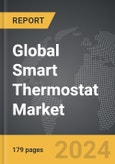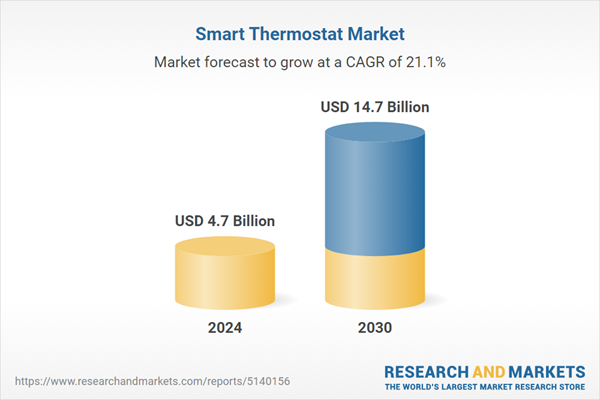The global market for Smart Thermostat was valued at US$4.7 Billion in 2024 and is projected to reach US$14.7 Billion by 2030, growing at a CAGR of 21.1% from 2024 to 2030. This comprehensive report provides an in-depth analysis of market trends, drivers, and forecasts, helping you make informed business decisions. The report includes the most recent global tariff developments and how they impact the Smart Thermostat market.
Segments: Component (Display, Temperature Sensor, Humidity Sensor, Motion Sensor, Other Components); End-Use (Residential, Commercial, Industrial).
Geographic Regions/Countries: World; United States; Canada; Japan; China; Europe (France; Germany; Italy; United Kingdom; and Rest of Europe); Asia-Pacific; Rest of World.
The analysts continuously track trade developments worldwide, drawing insights from leading global economists and over 200 industry and policy institutions, including think tanks, trade organizations, and national economic advisory bodies. This intelligence is integrated into forecasting models to provide timely, data-driven analysis of emerging risks and opportunities.
Global Smart Thermostat Market - Key Trends and Drivers Summarized
Smart Thermostat: Revolutionizing Energy Efficiency in Homes and Businesses
Smart thermostats are emerging as vital tools in energy management, offering automated temperature control, remote access, and energy consumption insights. Equipped with advanced features like learning algorithms, geofencing, and integration with smart home ecosystems, these devices optimize heating and cooling systems, leading to significant energy savings. Smart thermostats not only enhance comfort levels by maintaining ideal temperatures but also provide real-time data on energy usage, helping consumers make informed decisions to reduce their carbon footprint. They are becoming increasingly popular in both residential and commercial applications, providing benefits that range from convenience to cost efficiency.What Segments Are Shaping the Growth of the Smart Thermostat Market?
The smart thermostat market is segmented based on product type (learning, zoned, and smart programmable thermostats), technology (Wi-Fi, ZigBee, Z-Wave, and Bluetooth), and end-use (residential, commercial, and industrial). The residential segment dominates the market, driven by the increasing penetration of smart homes and the rising demand for energy-efficient solutions. However, the commercial segment is also witnessing significant growth due to the need for efficient energy management in offices, hotels, and retail spaces. The growing adoption of smart thermostats in industrial applications to optimize energy use in HVAC systems is further expanding the market.How Are Technological Advancements and Regulations Influencing Market Dynamics?
Technological advancements such as AI-driven learning capabilities, integration with smart speakers, and enhanced connectivity options are propelling the smart thermostat market. The ability to control thermostats through voice commands and smart home hubs is making these devices more user-friendly and attractive to consumers. Moreover, government regulations promoting energy efficiency and sustainability are encouraging the adoption of smart thermostats. Rebates and incentives provided by utility companies for installing energy-saving devices are also contributing to market growth. The increasing focus on reducing greenhouse gas emissions and achieving sustainability goals aligns well with the capabilities of smart thermostats, making them essential for modern buildings.What Are the Key Drivers of Growth in the Smart Thermostat Market?
The growth in the smart thermostat market is driven by several factors, including advancements in AI and machine learning, the rising adoption of smart home ecosystems, and increasing awareness of energy conservation. The expansion of smart city projects and the integration of IoT in residential and commercial buildings further support market growth. Government regulations and incentives for energy-efficient solutions, growing consumer demand for comfort and convenience, and the development of more advanced and affordable smart thermostats are significant drivers propelling the market forward.Report Scope
The report analyzes the Smart Thermostat market, presented in terms of units. The analysis covers the key segments and geographic regions outlined below.Segments: Component (Display, Temperature Sensor, Humidity Sensor, Motion Sensor, Other Components); End-Use (Residential, Commercial, Industrial).
Geographic Regions/Countries: World; United States; Canada; Japan; China; Europe (France; Germany; Italy; United Kingdom; and Rest of Europe); Asia-Pacific; Rest of World.
Key Insights:
- Market Growth: Understand the significant growth trajectory of the Display segment, which is expected to reach US$2.7 Billion by 2030 with a CAGR of a 18.5%. The Temperature Sensor segment is also set to grow at 24.0% CAGR over the analysis period.
- Regional Analysis: Gain insights into the U.S. market, valued at $1.3 Billion in 2024, and China, forecasted to grow at an impressive 20.1% CAGR to reach $2.2 Billion by 2030. Discover growth trends in other key regions, including Japan, Canada, Germany, and the Asia-Pacific.
Why You Should Buy This Report:
- Detailed Market Analysis: Access a thorough analysis of the Global Smart Thermostat Market, covering all major geographic regions and market segments.
- Competitive Insights: Get an overview of the competitive landscape, including the market presence of major players across different geographies.
- Future Trends and Drivers: Understand the key trends and drivers shaping the future of the Global Smart Thermostat Market.
- Actionable Insights: Benefit from actionable insights that can help you identify new revenue opportunities and make strategic business decisions.
Key Questions Answered:
- How is the Global Smart Thermostat Market expected to evolve by 2030?
- What are the main drivers and restraints affecting the market?
- Which market segments will grow the most over the forecast period?
- How will market shares for different regions and segments change by 2030?
- Who are the leading players in the market, and what are their prospects?
Report Features:
- Comprehensive Market Data: Independent analysis of annual sales and market forecasts in US$ Million from 2024 to 2030.
- In-Depth Regional Analysis: Detailed insights into key markets, including the U.S., China, Japan, Canada, Europe, Asia-Pacific, Latin America, Middle East, and Africa.
- Company Profiles: Coverage of players such as Control4 Corporation, Ecobee, Inc., Emerson Electric Co., Energate, Inc., Honeywell International, Inc. and more.
- Complimentary Updates: Receive free report updates for one year to keep you informed of the latest market developments.
Some of the 11 companies featured in this Smart Thermostat market report include:
- Control4 Corporation
- Ecobee, Inc.
- Emerson Electric Co.
- Energate, Inc.
- Honeywell International, Inc.
- Lennox International, Inc.
- Nest Labs, Inc.
- Schneider Electric SA
- Siemens Corporation
- Texas Instruments, Inc.
Tariff Impact Analysis: Key Insights for 2025
Global tariff negotiations across 180+ countries are reshaping supply chains, costs, and competitiveness. This report reflects the latest developments as of April 2025 and incorporates forward-looking insights into the market outlook.The analysts continuously track trade developments worldwide, drawing insights from leading global economists and over 200 industry and policy institutions, including think tanks, trade organizations, and national economic advisory bodies. This intelligence is integrated into forecasting models to provide timely, data-driven analysis of emerging risks and opportunities.
What’s Included in This Edition:
- Tariff-adjusted market forecasts by region and segment
- Analysis of cost and supply chain implications by sourcing and trade exposure
- Strategic insights into geographic shifts
Buyers receive a free July 2025 update with:
- Finalized tariff impacts and new trade agreement effects
- Updated projections reflecting global sourcing and cost shifts
- Expanded country-specific coverage across the industry
Table of Contents
I. METHODOLOGYII. EXECUTIVE SUMMARY2. FOCUS ON SELECT PLAYERSIII. MARKET ANALYSISIV. COMPETITION
1. MARKET OVERVIEW
3. MARKET TRENDS & DRIVERS
4. GLOBAL MARKET PERSPECTIVE
UNITED STATES
CANADA
JAPAN
CHINA
EUROPE
FRANCE
GERMANY
ITALY
UNITED KINGDOM
REST OF EUROPE
ASIA-PACIFIC
REST OF WORLD
Companies Mentioned (Partial List)
A selection of companies mentioned in this report includes, but is not limited to:
- Control4 Corporation
- Ecobee, Inc.
- Emerson Electric Co.
- Energate, Inc.
- Honeywell International, Inc.
- Lennox International, Inc.
- Nest Labs, Inc.
- Schneider Electric SA
- Siemens Corporation
- Texas Instruments, Inc.
Table Information
| Report Attribute | Details |
|---|---|
| No. of Pages | 179 |
| Published | April 2025 |
| Forecast Period | 2024 - 2030 |
| Estimated Market Value ( USD | $ 4.7 Billion |
| Forecasted Market Value ( USD | $ 14.7 Billion |
| Compound Annual Growth Rate | 21.1% |
| Regions Covered | Global |









